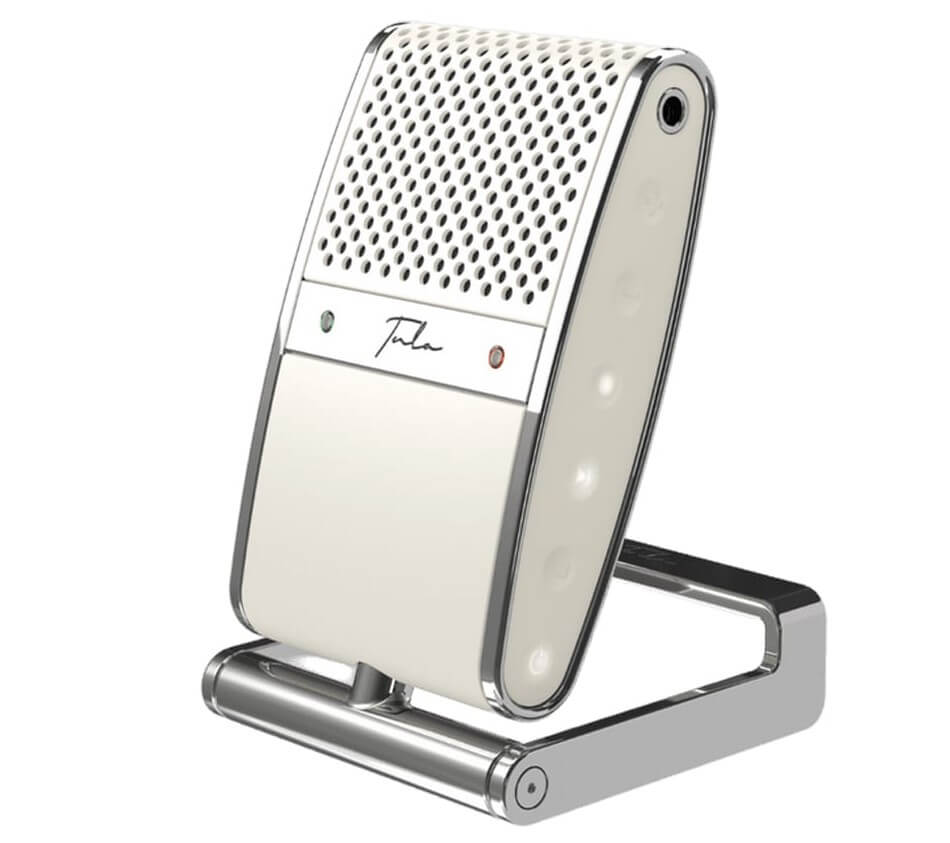
Two things I can doubtless be convicted of:
- Being an itinerant internet vagrant
- Being a techy geek
In the intersection of those two addictions, I found Tula.
Tula was an Indiegogo proposition. I think I found it there before RONA really kicked in.
But now, it’s here, and Tula is OO-La-La!
You are going to want to hear what Tula sounds like…and I have a comparison with a well-known, mainstream, large diaphragm mic at the end of this blog.
I also will post links and specs.
But let just start off by telling you how impressed I am with this diminutive microphone, and how it packs the wallop of a much more expensive offering.
Tula is well-designed. The tooling is exceptional. It’s surprisingly heavy. Yeah, all that…but we’ve seen a host of these portable mics come along, and almost all of them manage a mediocre sound at best. Not Tula.
Here are pics I took of mine when I first got it out of the box. It also comes in red and black.

The Tula base folds up to hold the mic at a comfortable angle and sits solidly in front of you. Not high enough? You can unscrew it from its base and instead screw in an adaptor (included) that will then fit on your mic stand. Nice!
A USB3.0 cable (included) connects your Tula in the back of the mic, and can be used to charge the mic and connect it to your computer. The other end is a typical USB-type plug.
Tula comes with 8GB built-in. It does not accept an SD card, which is an oversight I think, but maybe that’s in a future model.
No special software is needed…when you plug it in, it installs the requisite software in no time.
You can use it to record live on your computer’s DAW, or it will record internally as a stand-alone unit, then you download the native .wav recording onto your computer HD like it was an external drive.
This handy unit comes with both a switchable cardiod and omni capsule. It features Burr Brown op amps, a TI audio codec and a 3.5mm jack that functions a both a headphone output and an input for lavalier mic which is also included… clip, windscreen and all.
Noise reduction is built in to the Tula. This is from their website:
“The only way to get true background noise cancellation without a lot of unpleasant artifacts is to use an advanced AI system that recognizes the target audio and removes the rest. Fitting that onto a processor like the one used in Tula would be like an Elephant trying to ride a skateboard. So we searched far and wide to locate a system that could be optimized to fit our processor, would provide some useful nice reduction, AND wouldn’t affect the audio in a negative way. The best solution we found was a program called Brusfri, created by he Swedish software company, Klevgrand. Brusfri won’t remove your screaming kids or other loud background noises. Bit it wll take a normal sounding room and make it sound like a well-treated recording studio.”
There are switches on both sides. As it faces you…on the left: gain “+” and “-“. Fast Forward and Fast Reverse for replay (no exterior speaker), a mute button, a noise-cancellation toggle button and an omni/cardiod/lavalier toggle.
The other side has a headphone/lav mic jack, volume “+” and “-“, record/pause toggle, stop recording, play/pause, and on/off buttons.
There’s a green/orange/red gain meter, a record indicator button, and a battery level indicator.
Tula claims their rechargeable lithium ion battery will last through 14 hours of high-quality .wav recording using its internal memory.
You’ll be able to see the company line on their luxurious website: https://tulamics.com
On their website you can also get more specs, and even order a Tula. $200.

To the left is a quick iPhone pic of the orientation of the two mics for the audio demo you can listen to below. The top mic is a Lauten LA220.
My only regret is that I didn’t use a pop filter for the Tula. Being that it was below the Lauten made it even more susceptible to plosives. I did some creative editing in post to remove them, but that was an unfortunate oversight on my part.
The Tula does not come with any sort of mic screen, and for all they DO include with the package (including a fine carrying pouch), the package does not include a mic screen (except for the lav mic).
I recorded on both mics sumultlaneously…the Lauten through my Centrance R4, and the Tula as a stand-alone recorder (recording to its internal drive).
I edited both sound samples on Adobe Audition CS 2020, applying a noise reduction, normalizing, and finally adding a hard-limiter to -6db.
Honestly, the outcome amazed me.
I probably should’ve done a comparison to my TLM103 instead to make it fair.
I was surprised and the warmth, depth, and fullness of the Tula.
As far as I know I haven’t won this audition, but I’d like your reaction to the two different mic sounds.
The Tula is a little muddier, but honestly, I believe this little guy will go with me on my next trip as my portable go-to.
Please leave your thoughts in the comments below.
CourVO

 Listen to my Commercial demo
Listen to my Commercial demo